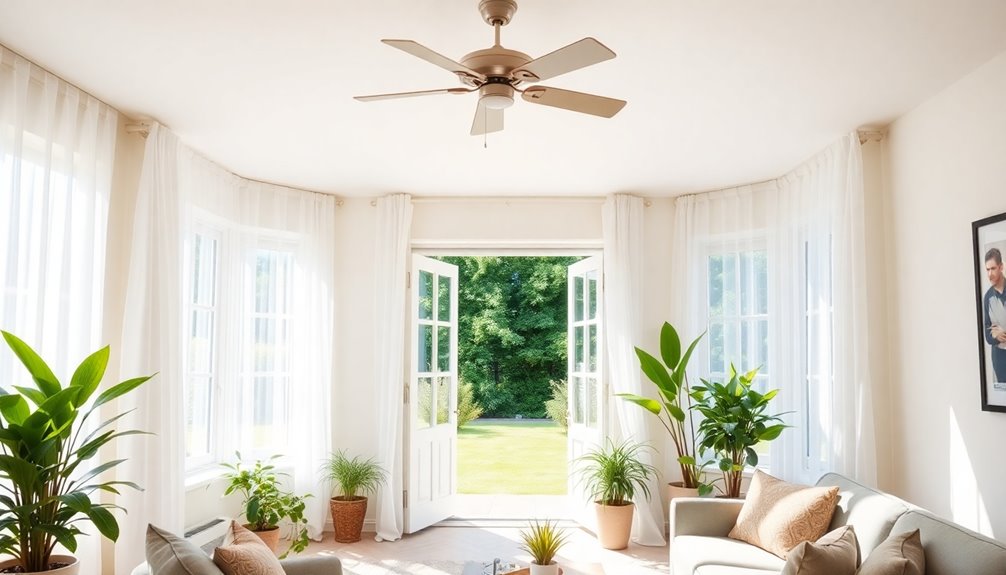To improve natural ventilation in your home, start by strategically orienting it with prevailing winds. Open windows on opposite sides to create effective cross ventilation. Utilize smaller openings for warm air escape while enhancing airflow with adjustable elements like sash windows and canopies. Incorporate ceiling fans to help circulate air. Also, consider the season when managing window openings for ideal airflow. There’s more to discover about enhancing your home’s ventilation for a breezier atmosphere.
Key Takeaways
- Properly orient your home to align with prevailing winds, maximizing fresh air intake through larger openings on the windward side.
- Create effective cross ventilation by opening windows on opposite sides to promote airflow and manage humidity levels with heat pumps.
- Utilize adjustable elements like sash windows and canopies to control air movement and direct cooler air inside.
- Incorporate the stack effect by positioning vents or windows at varying heights, allowing warm air to escape more efficiently.
- Adjust window openings seasonally to optimize airflow, reducing heat gain in warmer months and preventing heat loss in winter.
Understanding Natural Ventilation

When you think about creating a comfortable living environment, understanding natural ventilation is key. This eco-friendly method allows fresh outdoor air to circulate without mechanical devices, relying on wind and temperature differences.
The stack effect plays an important role here, letting warm air rise and escape through higher openings, while cooler air enters from below. For ideal air flow, cross ventilation is essential; by placing openings on opposite sides of a room, you create a current that pushes warm air out and pulls cool air in.
Additionally, the size and arrangement of these openings matter greatly. Smaller inlet openings combined with larger outlets can boost air velocity, ensuring consistent and effective natural ventilation throughout your living space. Incorporating eco-friendly practices such as using natural materials in construction can further enhance the overall air quality and comfort of your home.
The Importance of House Orientation

House orientation plays a significant role in enhancing natural ventilation, as it directly influences how air flows through your living space.
When you align your home with prevailing winds, larger openings on the windward side maximize fresh air intake, promoting better air exchange. Positioning your house at a 45-degree angle can create pressure on that side, facilitating improved airflow throughout.
Additionally, a well-oriented home can harness the stack effect, allowing hot air to rise and escape through higher openings, while cooler air enters from below. This concept is similar to how water parks feature lazy rivers, providing a natural flow that enhances the overall experience.
Creating Effective Cross Ventilation

To create effective cross ventilation, you need to optimize your window placement and utilize strategic openings.
Opening windows on opposite sides of your home lets cool air enter while warm air escapes, enhancing airflow. Additionally, incorporating heat pumps into your home can further improve indoor air quality by managing humidity levels effectively.
Optimize Window Placement
Optimizing window placement is essential for enhancing natural ventilation in your home, as strategically positioned windows can greatly improve airflow.
To optimize window placement, position larger openings on the windward side to invite fresh outdoor air inside, while smaller openings on the leeward side help warm air escape.
Verify your windows are at different heights; cooler air enters through lower openings, while hot air rises and exits through higher ones.
Orienting your house at a 45-degree angle to prevailing winds can create better air movement and pressure differences, enhancing cross ventilation.
Finally, consider installing operable windows that you can adjust based on weather conditions, allowing you to effectively optimize airflow and improve indoor air quality. Additionally, proper sealing methods for windows and doors can prevent drafts and ensure that the fresh air circulates effectively throughout your home.
Utilize Strategic Openings
Effective ventilation goes hand in hand with strategic openings throughout your home.
To create good ventilation and enhance air circulation, consider these tips:
- Position larger openings on the windward side for maximum airflow.
- Incorporate high-level openings to utilize the stack effect, letting warm air escape.
- Pair small inlet openings with larger outlet openings for higher air velocity.
- Adjust sashes, blades, and louvres to control airflow direction effectively.
- Make certain openings are present on both sides of the room for ideal cross ventilation.
Additionally, implementing advanced filtration systems can further improve indoor air quality by reducing allergens and pollutants during the ventilation process.
Optimizing the Size of Openings

When it comes to improving natural ventilation, the size of your openings plays a pivotal role in airflow dynamics. Small inlets paired with larger outlets can boost airflow effectiveness by enhancing air velocity. Conversely, larger inlets allow for increased air volume but reduce air velocity, making them ideal for bigger spaces. Tailoring the size of openings to wind direction can direct airflow efficiently, while balancing inlet and outlet sizes maximizes air exchange. Proper sizing is essential for improving airflow efficiency, ensuring comfortable indoor temperatures without relying heavily on mechanical systems. Additionally, incorporating an air purifier with HEPA filtration can further enhance indoor air quality by removing allergens and pollutants that may affect ventilation effectiveness.
| Opening Type | Effect on Airflow |
|---|---|
| Small Inlet | Higher velocity, effective |
| Large Inlet | Higher volume, lower velocity |
| Small Outlet | Direct airflow to areas |
| Large Outlet | Uniform air distribution |
Controlling Airflow With Adjustable Elements

Adjustable elements like sash windows and louvres give you the power to control how air moves through your home. By fine-tuning these features, you can enhance natural ventilation and create a more comfortable living space. Canopies can also play a role, helping to manage airflow and direct cooler air inside when it’s warm outside. Additionally, incorporating smart home automation can further optimize airflow and improve overall energy efficiency.
Sash Mechanisms for Airflow
Sash mechanisms play an essential role in optimizing airflow within your home. By adjusting these elements, you can greatly improve your home’s natural ventilation.
Consider the following benefits:
- Control the size of window openings for better airflow
- Utilize reversible pivot sash windows to direct air as needed
- Enhance ventilation efficiency with strategically placed canopies
- Target airflow direction using adjustable louvre blades
- Reduce reliance on mechanical systems for fresh air
Incorporating sash mechanisms allows you to manage indoor air movement based on weather conditions. Additionally, understanding user privacy can help you make informed decisions about the ventilation systems you choose to implement.
By effectively utilizing these adjustable features, you can guarantee better indoor air quality while creating a comfortable living environment.
Don’t underestimate the power of these simple changes to enhance ventilation in your home!
Blade and Louvre Adjustments
Utilizing sash mechanisms can enhance your home’s ventilation, but blade and louvre adjustments take that control a step further.
These adjustments let you manage the angle and position of openings, effectively directing airflow within your ventilation system. By angling blades or louvers upward, you can promote the stack effect, allowing warm air to escape, while downward angles help direct cooler air into your living space.
This control reduces drafts and maintains a comfortable temperature throughout your home. Properly positioned blades and louvers greatly influence airflow patterns, enhancing natural ventilation and improving indoor air quality. Additionally, incorporating vintage or distressed furniture can complement the overall aesthetic while ensuring that airflow remains unobstructed in your living spaces.
Canopy Pressure Management
While you may not think about it often, managing canopy pressure can have a considerable impact on your home’s airflow. By adjusting elements like canopies, you can create a downward pressure effect that enhances your ventilation strategy.
Consider these tips for effective canopy pressure management:
- Use adjustable blades and louvers to direct airflow.
- Install sashes that pivot or reverse for versatile airflow options.
- Design gaps between the facade and canopy to enhance pressure differentials.
- Make sure your canopies are positioned to maximize exposure to fresh air.
- Regularly assess and adjust your setup to maintain ideal airflow.
Additionally, ensuring that your home has high contrast ratios can further improve your indoor environment by enhancing the perceived quality of ambient light.
With proper management, you can greatly improve indoor air quality, making certain a steady stream of fresh air while reducing reliance on mechanical systems.
Utilizing the Stack Effect for Air Movement

When warm air rises and escapes through higher openings, it creates a natural airflow that can enhance ventilation in your home. This phenomenon, known as the stack effect, relies on the pressure difference between warm air and cool air.
To make the most of it, place vents or windows at various heights, like operable windows at the top of stairwells or in high ceilings. Ascertain these upper openings are larger than the lower ones to allow more warm air to escape, increasing the influx of cooler air.
During warmer months, open windows during cooler parts of the day to facilitate fresh air flow. Additionally, proper insulation and sealing gaps can help maintain temperature differences, boosting overall ventilation efficiency.
Enhancing Ventilation With Ceiling Fans

Ceiling fans are a simple yet effective way to enhance natural ventilation in your home. They create a wind chill effect, making you feel cooler without adjusting the temperature.
Here are some benefits of using ceiling fans:
- Improved airflow in living spaces
- Energy efficiency by reducing air conditioning use
- Versatile year-round use by reversing direction
- Strategic placement for better cross-ventilation
- Appropriate sizing for ideal performance
In the summer, set your ceiling fans to rotate counterclockwise to push cool air down.
In winter, switch to clockwise to circulate warm air.
The Role of Windows in Natural Ventilation

Windows are key to enhancing natural ventilation in your home.
By strategically placing and sizing them, you can greatly improve airflow and comfort.
Let’s explore effective opening techniques and design choices that promote fresh air circulation.
Window Placement Strategies
How can the strategic placement of windows enhance natural ventilation in your home?
Proper window placement is key to maximizing airflow and improving ventilation in your house. Here are some tips to take into account:
- Position larger windows on the windward side for better airflow.
- Align windows at a 45-degree angle to capture prevailing winds.
- Guarantee openings on both sides for effective cross-ventilation.
- Use larger windows to increase air volume, but take into account smaller ones for targeted airflow.
- Incorporate adjustable sashes or louvers to control airflow direction.
Opening Techniques for Airflow
Effective window placement sets the stage for maximizing airflow, but the techniques you use to open those windows can make all the difference in enhancing natural ventilation. Open your windows for at least five minutes daily to improve air inside; for the best results, aim for 15 to 20 minutes. Create a cross breeze by opening windows on the windward side and doors opposite to bring in fresh air while removing stale air.
| Opening Technique | Benefits |
|---|---|
| Full window openings | Maximizes airflow and ventilation |
| Smaller inlet, larger outlet | Increases air velocity for better flow |
| Regular maintenance | Guarantees windows function properly |
Window Size and Design
Natural ventilation relies heavily on the size and design of your windows, which can greatly impact airflow in your home.
Here are some key considerations:
- Larger windows facilitate better air exchange, letting fresh air in and stale air out.
- Position windows for ideal cross ventilation, with smaller inlet openings and larger outlet openings.
- Use operable sashes and casements to adjust airflow based on weather and comfort.
- Incorporate awnings or overhangs to control sunlight while ensuring proper ventilation.
- Orient windows towards prevailing winds to enhance overall air circulation.
Seasonal Considerations for Natural Airflow

As the seasons change, your approach to natural airflow should adapt to maximize comfort and energy efficiency in your home.
In warmer months, open your windows during cooler times, like early morning or late evening, to let in fresh air while reducing heat gain.
During spring and fall, enhance ventilation and air quality by creating cross ventilation; open windows on opposite sides to facilitate airflow.
In winter, limit window openings to short bursts to prevent heat loss, but consider vents for fresh air exchange without sacrificing warmth.
Always monitor outside air quality; on high pollen or pollution days, keep windows closed.
Adjust window orientations with seasonal changes in wind direction for ideal airflow year-round.
Maintaining Your Home for Optimal Ventilation

With the changing seasons influencing your home’s ventilation, keeping your space well-maintained is key to ensuring ideal airflow year-round.
Here are some essential maintenance tips:
- Regularly clean windows and screens for unobstructed fresh air flow.
- Monitor your home’s orientation to leverage prevailing winds.
- Open windows on opposite sides for effective cross ventilation.
- Inspect and clean vents and louvers to prevent blockages.
- Adjust window openings during cooler times for peak airflow.
Frequently Asked Questions
How Can I Improve the Air Flow in My House?
To improve the airflow in your house, start by opening windows for at least 15 to 20 minutes daily.
Create a cross breeze by opening windows on the windward side and doors on the opposite side.
Position larger openings where the wind hits to maximize fresh air intake, while keeping smaller openings for exhaust.
Use high-level openings to let warm air escape and cool air in, ensuring a consistent flow throughout your home.
How Do You Maximize Natural Ventilation?
To maximize natural ventilation, you’ll want to strategically position your windows.
Open them on opposite sides of your home to create cross ventilation, letting cool air in and warm air out.
Align larger openings with the wind to enhance airflow and utilize the stack effect by placing higher openings for hot air to escape.
Regularly check and adjust your window mechanisms to optimize airflow based on changing weather conditions.
How Do You Know if Your House Has Poor Ventilation?
Picture stepping into a stuffy room where musty smells cling to the air like a damp blanket.
You notice condensation on the windows, and the walls seem to weep.
If you’re sneezing more often or battling allergies, it’s a sign your home’s air quality’s suffering.
Visible mold growth and high humidity levels can signal poor ventilation too.
Trust your senses; if something feels off, your house might be craving some fresh air.
How to Get Fresh Air Into a Tight House?
To get fresh air into a tight house, you can start by opening windows on opposite sides to create a cross breeze. This allows fresh air to flow in and stale air to escape.
You should also consider utilizing the stack effect by opening higher windows, letting warm air rise and exit, which pulls in cooler air from below.
Regularly check for any obstructions to guarantee airflow isn’t blocked.
Conclusion
Incorporating these strategies for natural ventilation can really help you breathe easy at home. By understanding how your house’s orientation, openings, and airflow control work, you can create a comfortable living environment. Don’t forget to keep windows and fans in mind, too! With a little effort, you’ll have a home that’s fresh and inviting. Remember, when it comes to ventilation, it’s all about thinking outside the box for the best results.










